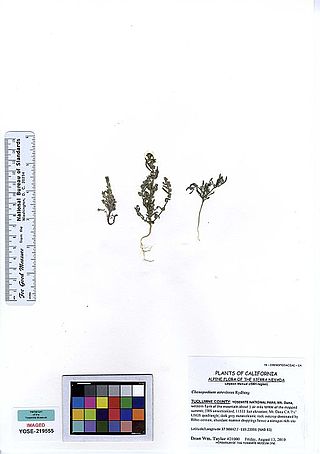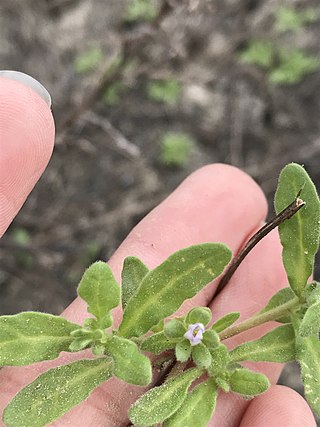
Dendromecon harfordii, known by the common names Channel Islands tree poppy and Harford's tree poppy, is a species of flowering plant in the poppy family.

Zeltnera muehlenbergii is a species of annual herb commonly known as Monterey centaury and Muhlenberg's centaury. It is native to western North America from British Columbia to California and Nevada, where it commonly grows in forests and other moist places. This is an annual herb growing thin, erect, branching stems to heights anywhere between 10 centimeters and one meter. Oval-shaped leaves are arranged oppositely on the stem and are up to 2 or 3 centimeters long. The branching inflorescence bears many flowers, each with small bracts at its base. The flower has five oval-shaped petallike lobes each a few millimeters long.

Arctostaphylos pechoensis is a species of manzanita known by the common name Pecho manzanita. It is endemic to California, where it is known only from the Pecho Hills southwest of San Luis Obispo in San Luis Obispo County, California.

Arctostaphylos rudis, with the common names Shagbark manzanita and Sand mesa manzanita, is a species of manzanita.

Chenopodium atrovirens is a species of flowering plant in the amaranth family known by the common names pinyon goosefoot and dark goosefoot.

Gratiola neglecta is a species of flowering plant known by the common name clammy hedgehyssop. It is native to much of North America, including most all of the United States and the southern half of Canada. It is generally found in moist to wet habitat. This is an unobtrusive annual herb producing a glandular stem up to about 30 centimeters tall. The lance-shaped to oval leaves are arranged oppositely about the stem. They are up to 5 centimeters long and sometimes toothed along the edges. The inflorescence is a raceme of nearly cylindrical tubular whitish flowers each about a centimeter long. At the base of each flower is a fringe of five pointed sepals. The fruit is a spherical capsule about half a centimeter wide.

Nama stenocarpa is a species of flowering plant in the borage family known by the common name mud fiddleleaf. It is native to northern Mexico and areas of southern California, Arizona, and Texas, where it is known from wet habitat such as marshes and swampy valley wetlands.
Nemacladus gracilis is an uncommon species of flowering plant in the bellflower family known by the common names slender threadplant or slender nemacladus. It is endemic to California, where it is known from the Transverse Ranges and adjacent mountains, desert, and valley territory. It can be found in rocky and sandy areas in woodland and grassland habitat. It is a small annual herb producing an upright reddish brown stem no more than about 10 centimeters long. Small lobed oval leaves under a centimeter long occur at the base of the plant. The inflorescence is a series of branches bearing occasional flowers on thin, curving pedicels. There is a single tiny bract at the base of each pedicel. The flower is only about 2 millimeters long. It has five lavender-veined white lobes fused along the lower half.
Nemacladus ramosissimus is a species of flowering plant in the bellflower family known by the common name smallflower threadplant. It is native to the mountains and deserts of the southern half of California and adjacent parts of Baja California. It is a small annual herb producing a thread-thin erect brown or purplish stem up to about 32 centimeters tall. Lobed oval leaves under 2 centimeters long occur at the base of the plant. The inflorescence is a series of branches bearing occasional flowers on thin, curving pedicels. There is a single small bract at the base of each pedicel. The flower is no more than 2 millimeters long with five white lobes fused along the lower half.
Phacelia gymnoclada is a species of phacelia known by the common name nakedstem phacelia. It is native to the western Great Basin of the United States, where it can be found in the scrublands of Nevada, Oregon, and the eastern edge of California.

Phacelia stellaris is a rare species of flowering plant in the borage family, Boraginaceae, known by the common names star phacelia and Brand's phacelia.

Stellaria calycantha is a species of flowering plant in the family Caryophyllaceae known by the common name northern starwort. It is native to western North America from Alaska and northwestern Canada to California and New Mexico, as well as eastern Russia. It occurs in subalpine and alpine climates, in many types of moist, shady habitats. It is a rhizomatous perennial herb producing a prostrate to erect stem up to 25 centimeters long, taking a clumpy form. The thin oval leaves have smooth edges and pointed tips, and measure up to 2.5 centimeters in length. The inflorescence bears one or more flowers, each on a long pedicel. Each flower has five pointed green sepals, and some flowers have up to five deeply lobed white petals.

Stellaria longifolia is a species of flowering plant in the family Caryophyllaceae known by the common name longleaf starwort. It is native to much of the northern half of the Northern Hemisphere, occurring throughout northern Europe and North America. It grows in many types of moist habitat, including meadows, marshes, and roadsides. It is a rhizomatous perennial herb forming clumps with sprawling, branching stems which are mostly hairless except for tiny rough hairs along the edges of the squarish stem. The linear to lance-shaped leaves are up to 3.5 centimeters long and are oppositely arranged in pairs. The inflorescence bears several flowers, each on a short pedicel. The flower has five pointed green sepals each a few millimeters long. There are five white petals, each so deeply lobed it appears to be two.

Stellaria obtusa is a species of flowering plant in the family Caryophyllaceae known by the common names Rocky Mountain chickweed, blunt-sepaled starwort, and obtuse starwort. It is native to western North America, from British Columbia and Alberta to California to Colorado, where it grows in moist areas in forests and on mountain slopes.
Streptanthus barbatus is a species of flowering plant in the mustard family known by the common name Pacific jewelflower. It is endemic to the southern Klamath Mountains of far northern California, where it occurs in open wooded habitat among Jeffrey Pines, generally on serpentine soils. It is a perennial herb producing a decumbent or erect, sometimes branching stem up to 70 to 90 centimeters long. It is hairless except for some light hairs on the flowers and the bases of the leaves. The largest leaves are at the base of the plant. They are oval with faintly toothed, bristly edges and borne on short petioles. Leaves above these are oval to rounded and may clasp the stem. Flowers occur at intervals along the upper stem. Each has a spherical to urn-shaped calyx of keeled sepals under a centimeter long with curving petals barely emerging from the tip. The calyx of sepals is whitish, darkening purple in maturity. The petals are purple. The fruit is a long, flat, curving silique which may be 7 centimeters in length.
Streptanthus barbiger is a species of flowering plant in the mustard family known by the common name bearded jewelflower. It is endemic to California, where it is limited to the North Coast Ranges. It grows in woodlands and chaparral habitat, often on serpentine soils. It is an annual herb producing a branching stem up to about 80 centimeters in maximum height. Leaves near the base of the stem are lance-shaped to oval and pointed, usually with toothed edges, the blades measuring up to 7 centimeters long. Leaves higher on the stem may be longer but are narrower and have smooth edges. Flowers occur at intervals along the upper stem. Each has a spherical to urn-shaped calyx of greenish yellow or purple sepals under a centimeter long. Whitish or purple-tinged petals up to a centimeter long emerge from the tip. The fruit is a long, flat, curving silique which may be 7 centimeters in length.
Streptanthus batrachopus is a rare species of flowering plant in the mustard family known by the common name Mt. Tamalpais jewelflower. It is endemic to Marin County, California, where it is known only from Mt. Tamalpais and surrounding terrain. There are fewer than ten known occurrences.

Streptanthus longisiliquus is a species of flowering plant in the mustard family known by the common name long-fruit jewelflower. It was first described to science in 2007. It is endemic to northern California, where it is known from Butte, Tehama, and Shasta Counties. It can be found in forest and woodland habitat in mountains and foothills. It is a short-lived perennial herb producing a few-branched stem up to 1.2 to 1.5 meters in maximum height. It is mostly hairless except for some light hairs on the inflorescences and sometimes the leaf petioles. The basal leaves have oval or spoon-shaped blades up to 10 centimeters long, usually with smooth edges. Leaves higher on the stem are oval or oblong and lack petioles, their bases often clasping the stem. Flowers occur at intervals along the upper stem. Each flower has a bell-shaped calyx of sepals which yellow-green at the base and purplish at the tip, measuring under a centimeter in length. The petals emerging from the end are brownish or purplish with greenish bases. The fruit is a flattened, curving silique that can be quite long even for the genus, measuring up to 15 centimeters in length.

Zizania texana is a rare species of grass known by the common name Texas wild rice. It is endemic to Texas, where it is found only on the upper San Marcos River in Hays County. It is threatened by the loss and degradation of its habitat. It is a federally listed endangered species of the United States.

Nolina texana, the Texas sacahuiste or Texas beargrass, is a plant in the asparagus family that resembles a large clump of grass. It grows in the south central United States and Northern Mexico. They are sometimes grown as a garden plant in xeriscape or native plant gardens.















